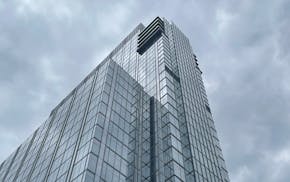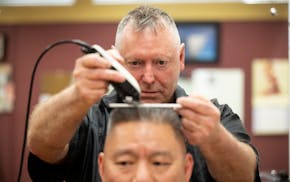Maricela Gallarzo, owner of Planet Smoothie in downtown Minneapolis, is grateful for Sam Campbell.
Each weekday morning, Campbell buys a 44-ounce yogurt smoothie laden with blueberries, strawberries and protein powder for $9.99.
"I've been doing this for two years," Campbell said last week. "It's healthier than McDonald's and I love it. ... If she goes out of business, I wouldn't know what to do."
Gallarzo is one of the few remaining Gaviidae Common merchants. She also owes $18,000 in back rent. The struggle has been common among downtown restaurants and stores as office tower employees started working from home at the beginning of the pandemic two years ago.
Gallarzo, who works up to 12 hours a day at her smoothie business and some nights for her husband's office-cleaning business, saw daily sales go from 80-plus smoothies when she opened in January 2020 to under 10 during the bleakest winter days of the two-year pandemic.
"I love this business and there's no going back," Gallarzo said. "This winter has gotten better. We're averaging 30 or 35 smoothies a day. I know we can average 100 by summer. We just need more people."
She noticed an uptick in traffic last week, as the city of Minneapolis and a few other major employers began recalling workers back to the office as the latest COVID-19 wave subsided.
The Minneapolis Building Owners and Managers Association (BOMA) and Downtown Council estimate up to 40% of downtown's 216,000 workers have returned. However, most office employers use a hybrid model, so workers are not on site every day.
Mayor Jacob Frey and business and event leaders have urged a return to downtown offices. They also are urging people to go out to eat and to cultural and sporting events.
Even if COVID-19 numbers stay low, the process of returning downtown is going to be more of a weekslong process instead of an all-at-once change, by all indications.
There's "realistic optimism" for a downtown recovery, said Downtown Council CEO Steve Cramer.
Success might might be 100,000, or half the workforce, on a warm spring day, who consolidate shopping, skyway lunching and post office and other errands into those workdays.
Staff at Fluid Interiors, a 90-empoyee Butler Square-based firm that designs and furnishes office space, started returning on a hybrid basis in September.
Megan Duffy, Fluid's veteran director of creative and client services, said business is improving and furloughed employees are back, but 2022 revenue will fall short of 2019. Clients want less "cubicle farms" and more "open-office solutions with flexibility." In other words, company space with fewer offices but more places where people can plug in their computers.
Downtown looks good after two years of renovation, cleaning and updating. Minneapolis issued $1.6 billion in construction permits in 2021, the 10th year in a row that more than $1 billion worth were issued.
Downtown has been a big beneficiary.
The residential population has grown 37% to 56,000 since 2016, including last year. And hundreds of thousands of downtown patrons attended concerts, sports events and theater, albeit far fewer than 2019.
Moreover, downtown businesses actually absorbed 176,000 square feet of office space, thanks to new tenants, space repurposing and expansions.
All that said, about half of the skyway shops remain vacant.
Jim Durda, general manager of City Center for Ryan Cos., made building investments that helped replace vacating retailers with Chase and Bell bank branches. A number of small retailers and eateries have reopened, stayed open or will return, he said, thanks partly to rent discounts since 2020.
The Downtown Council, funded mostly by big employers, provided $1.5 million in grants to 102 struggling small businesses in 2020 and 2021.
Crime and its perception are an obstacle. Violent crime was up 10% last year downtown from the previous four-year average, according to police statistics. And lesser crimes dropped.
Downtown boosters note that 90% of violent crimes occur outside downtown. Still, there is the perception of downtown as a dangerous place, partly because it's been somewhat desolate since 2020. Commerce and everyday traffic on the street deter crime, the police say.
"We've been fighting the 'war-zone, not-safe' messaging from clients and even some of our employees," conceded Mike Salman, who leads a team that manages four downtown skyscrapers for Transwestern. "And we're not downplaying recent tragic events. There are issues that need to be addressed. But it is not as bad as we hear. We need to get people back downtown. The more they come downtown, there will be less concern."
Salman and about a dozen building managers — recently joined by the Downtown Council, Meet Minneapolis, BOMA, the city and other partners — are planning an "adopt a block" program to start in March. Corporate volunteers will welcome folks back downtown, host coffee gatherings, staff street and skyway events and provide discount coupons from participating restaurants and businesses.
"We want to see downtown back to where it was pre-COVID," Salman said.
Kelly Zenk, 36-year owner of Ginelli's Pizza in the skyway of the 121 S. 8th St. building, is starting to witness more business, a pickup from about 10% of 2019 levels to 40%.
He kept six employees on payroll at the same hours, thanks partly to a federal Payroll Protection Program loan. Two workers left during the pandemic.
But he won't expand his 8 a.m.-to- 1:30 p.m. hours until he sees more demand.
"By summer of this year we might see 50 percent or 60 percent of the business we had before," he said as he made pizzas early one morning last week. "I don't think it's ever going to be what it once was."

St. Anthony: 'Patient' investing paying off for St. Paul's Hill Capital

Jennifer Smith, leader of Burnsville's Innovative Office Solutions, has died

St. Anthony: Medical professions in Minnesota need more people of color in their ranks



